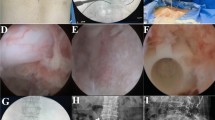Abstract
Purpose
Our team designed a novel two-medium compatible bichannel endoscopy system for spinal surgery, V-shape bichannel endoscopy (VBE) system. Hereby, this study will introduce minimally invasive transforaminal lumbar interbody fusion (TLIF) with VBE system and report its preliminary clinical results.
Methods
Fifty-two participants, who accepted VBE-assisted TLIF surgery (VBE-TLIF) in our hospital were included in this study. The duration of operation, off-bed time, and days of hospitalization were recorded. Besides, the patient’s preoperative and postoperative pain were evaluated via visual analog scale (VAS), the functional status was evaluated via Oswestry dysfunction index (ODI) and modified MacNab criteria. Patients were asked to follow-up in the outpatient department at the 3rd, 6th, 12th, and 24th month after surgery. X-ray or CT was examined to evaluate the internal fixation position and interbody fusion result.
Results
All patients received unilateral decompression with an average operation duration of 178.49 ± 27.49 min. After the surgery, their VAS score of leg pain and back pain reduced significantly. At the last follow-up, the VAS score of leg pain and back pain was 0.80 ± 0.69 and 0.86 ± 0.75 separately. The difference shows statistically significant with p < 0.05. At the last follow-up, the ODI was 15.20 ± 5.75. According to modified MacNab criteria, 39 patients rated their function as excellent, and 10 patients were good. The overall satisfaction rate reached 94%.
Conclusion
The VBE system reported in the current study can complete TLIF surgery safely and effectively.





Similar content being viewed by others
Data availability
The raw data can be provided by the authors and their institutions.
References
Yavin D, Casha S, Wiebe S, Feasby TE, Clark C, Isaacs A, Holroyd-Leduc J, Hurlbert RJ, Quan H, Nataraj A, Sutherland GR, Jette N (2017) Lumbar fusion for degenerative disease: a systematic review and meta-analysis. Neurosurgery 80:701–715. https://doi.org/10.1093/neuros/nyw162
Chen X, Chamoli U, Lapkin S, Castillo JV, Diwan AD (2019) Complication rates of different discectomy techniques for the treatment of lumbar disc herniation: a network meta-analysis. Eur Spine J Off Public Eur Spine Soc Eur Spinal Deform Soc Eur Sect Cerv Spine Res Soc 28:2588–2601. https://doi.org/10.1007/s00586-019-06142-7
Kim CH, Chung CK, Choi Y, Kim M-J, Yim D, Yang SH, Lee CH, Jung J-M, Hwang SH, Kim DH, Yoon JH, Park SB (2019) The long-term reoperation rate following surgery for lumbar herniated intervertebral disc disease: a nationwide sample cohort study with a 10-year follow-up. Spine 44:1382–1389. https://doi.org/10.1097/BRS.0000000000003065
Chen G, Li LB, Shangguan Z, Wang Z, Liu W, Li J (2022) Clinical Effect of minimally invasive microendoscopic-assisted transforaminal lumbar interbody fusion for single-level lumbar disc herniation. Orthop Surg. https://doi.org/10.1111/os.13443
Ahn Y, Youn MS, Heo DH (2019) Endoscopic transforaminal lumbar interbody fusion: a comprehensive review. Expert Rev Med Devices 16:373–380. https://doi.org/10.1080/17434440.2019.1610388
Wagner R, Haefner M (2020) Uniportal endoscopic lumbar interbody fusion. Neurospine 17:S120-s128. https://doi.org/10.14245/ns.2040130.065
Heo DH, Son SK, Eum JH, Park CK (2017) Fully endoscopic lumbar interbody fusion using a percutaneous unilateral biportal endoscopic technique: technical note and preliminary clinical results. Neurosurg Focus 43:E8. https://doi.org/10.3171/2017.5.Focus17146
Morgenstern C, Yue JJ, Morgenstern R (2019) Full percutaneous transforaminal lumbar interbody fusion using the facet-sparing. Trans-Kambin Approach Clin Spine Surg. https://doi.org/10.1097/BSD.0000000000000827
Shen J (2019) Fully endoscopic lumbar laminectomy and transforaminal lumbar interbody fusion under local anesthesia with conscious sedation: a case series. World Neurosurg 127:e745–e750. https://doi.org/10.1016/j.wneu.2019.03.257
Park MK, Park SA, Son SK, Park WW, Choi SH (2019) Clinical and radiological outcomes of unilateral biportal endoscopic lumbar interbody fusion (ULIF) compared with conventional posterior lumbar interbody fusion (PLIF): 1-year follow-up. Neurosurg Rev 42:753–761. https://doi.org/10.1007/s10143-019-01114-3
Diaz RR, Savardekar AR, Brougham JR, Terrell D, Sin A (2021) Investigating the efficacy of allograft cellular bone matrix for spinal fusion: a systematic review of the literature. Neurosurg Focus 50:E11. https://doi.org/10.3171/2021.3.Focus2179
Villavicencio AT, Nelson EL, Rajpal S, Beasley K, Burneikiene S (2022) Prospective, randomized, double-blinded clinical trial comparing PEEK and allograft spacers in patients undergoing transforaminal lumbar interbody fusion surgeries. Spine J 22:84–94. https://doi.org/10.1016/j.spinee.2021.06.005
Acknowledgement
Haijian Ni and Shisheng He contributed to the study conception and design. Material preparation, data collection, and analysis were performed by all authors. The first draft of the manuscript was written by Haoyu Gong and revised by Haijian Ni and Shisheng He. All authors read and approved the final manuscript. We specially thanks Dragon Crown Medical Company for helping in designing and producing VBE system.
Funding
The authors declare that no funds, grants, or other supports were received during the preparation of this manuscript.
Author information
Authors and Affiliations
Corresponding authors
Ethics declarations
Conflict of interests
The authors have no competing interests to declare that are relevant to the content of this article.
Ethical approval
This study was performed in line with the principles of the Declaration of Helsinki. Approval (20KT144) was granted by the Ethics Committee of Shanghai Tenth People’s Hospital.
Consent to participate
Informed consent was obtained from all individual participants included in the study.
Consent to publish
No identifying details of the participants appeared in this paper.
Additional information
Publisher's Note
Springer Nature remains neutral with regard to jurisdictional claims in published maps and institutional affiliations.
Rights and permissions
Springer Nature or its licensor (e.g. a society or other partner) holds exclusive rights to this article under a publishing agreement with the author(s) or other rightsholder(s); author self-archiving of the accepted manuscript version of this article is solely governed by the terms of such publishing agreement and applicable law.
About this article
Cite this article
Gong, H., Fan, Y., Zhao, Y. et al. Minimally invasive transforaminal lumbar interbody fusion by a novel two-medium compatible bichannel endoscopy system, technique note and preliminary clinical results. Eur Spine J 32, 2845–2852 (2023). https://doi.org/10.1007/s00586-023-07746-w
Received:
Revised:
Accepted:
Published:
Issue Date:
DOI: https://doi.org/10.1007/s00586-023-07746-w




